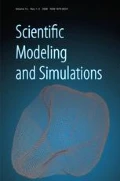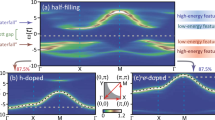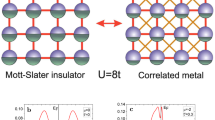Abstract
Charge-spin separation and pairing fluctuations and pseudogaps are studied using the analytical eigenvalues of the four-site Hubbard Nanoclusters with the grand canonical and canonical ensemble approaches in a multidimensional parameter space of temperature (T), magnetic field (h), on-site interaction (U), chemical potential (μ), and number of electrons (N). The electron charge energy gap, with one hole off half filling, corresponds to an excitonic particle–hole pair binding energy Δe-h > 0 at U > U c and vanishes at a critical parameter U c = 4.584. For U < U c, particle–particle pair binding is found with a pairing energy Δp > 0. In addition, for U ⩽ U c we find an electron pair binding instability at finite temperature near N ≈ 3, which manifests a possible pairing mechanism, a precursor to superconductivity, in small clusters. The resulting phase diagram, consisting of charge and spin pseudogaps, hole pairing near 1/8th filling with hole-rich and hole-poor regions in the ensemble of Nanoclusters, closely resembles the phase diagrams in the family of doped high-T c-cuprates.
Similar content being viewed by others
References
Anderson P.W. (1987) The resonating valence bond state in La2CuO4 and superconductivity. Science 235: 1196–1198
Emery V., Kivelson S.A. (1995) Importance of phase fluctuations in superconductors with small superfluid density. Nature (Lond.) 374: 434–437
Timusk T., Statt B. (1999) The pseudogap in high-temperature superconductors: An experimental survey. Rep. Prog. Phys. 62, 61–122
Kivelson S.A., Bindloss I.P., Fradkin E., Oganesyan V., Tranquada J.M., Kapitulnik A., Howald C. (2003) How to detect fluctuating stripes in the hightemperature superconductors. Rev. Mod. Phys. 75: 1201–1241
Damascelli A., Hussain Z., Shen Z.X. (2003) Angle-resolved photoemission studies of the cuprate superconductors. Rev. Mod. Phys. 75: 473–541
Anderson P.W. (1997) A re-examination of concepts in magnetic metals: The ‘nearly antiferromagnetic Fermi liquid.’ Adv. Rev. 46: 3–11
Williams G.V.M., Tallon J.L., Loram J.W. (1998) Crossover temperatures in the normal-state phase diagram of high-Tc superconductors. Phys. Rev. B 58: 15053
Emery V.J., Kivelson S.A., Zachar O. (1997) Spin-gap proximity effect mechanism of high-temperature superconductivity. Phys. Rev. B 56: 6120–6147
Zha Y., Barzykin V., Pines D. (1996) NMR and neutron-scattering experiments on the cupratesuperconductors: A critical re-examination. Phys. Rev. B 54: 7561–7574
Kocharian A.N., Fernando G.W., Palandage K., Davenport J.W. (2006) Thermodynamic properties, magnetism and Mott-Hubbard-like transitions in nanoscale clusters. J. Mag. Mag. Mater. 300, e585–e590
Kocharian A.N., Fernando G.W., Palandage K., Davenport J.W. (2006) Exact study of charge-spin separation, pairing fluctuations, and pseudogaps in four-site Hubbard clusters. Phys. Rev. B 74, 024511
Tsai W.F., Kivelson S.A. (2006) Inhomogeneous Hubbard models: from weak to strong coupling, cond-mat/0601113. APS March Meet. Bull. 51(Part 2): 1
Schumann R. (2002) Thermodynamics of a 4-site Hubbard model by analytical diagonalization. Ann. Phys. 11: 49–87
Fye R.M., Martins M.J., Scalettar R.T. (1990) Binding of holes in one-dimensional Hubbard chains. Phys. Rev. B 42: 6809–6812
White S.R., Chakravarty S., Gelfand M.P., Kivelson S.A. (1992) Pair binding in small Hubbard-model molecules. Phys. Rev. B 45: 5062–5065
Author information
Authors and Affiliations
Corresponding author
Rights and permissions
About this article
Cite this article
Palandage, K., Fernando, G.W., Kocharian, A.N. et al. An exact study of pairing fluctuations and phase diagrams in four-site Hubbard Nanoclusters. J Computer-Aided Mater Des 14, 103–108 (2007). https://doi.org/10.1007/s10820-006-9024-y
Published:
Issue Date:
DOI: https://doi.org/10.1007/s10820-006-9024-y




